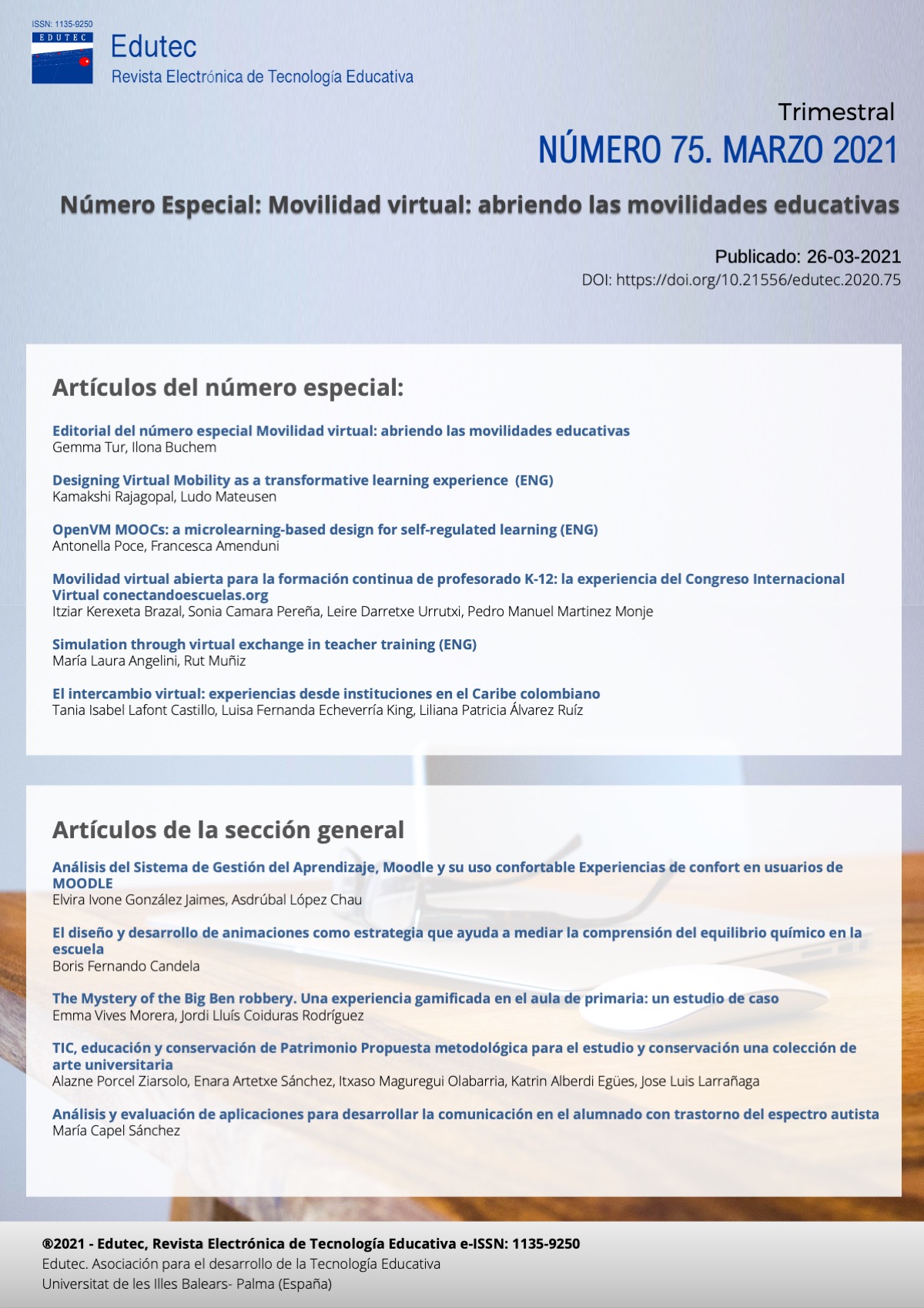Special issue editorial. Virtual mobility: opening up educational mobilities
DOI:
https://doi.org/10.21556/edutec.2021.75.1987Keywords:
virtual mobility, collaboration, online learning, Internationalization, virtual exchangeAbstract
The characterization virtual mobility is based on three main conceptual pillars – international, digital and collaborative. We understand that these characteristics are common to other related concepts although an institutional agreement and the transcript of records for the exchange and recognition of credits seems to be a distinct characteristic of virtual mobility. A recent approach to virtual mobility has added the dimension of open education as the fourth pillar of virtual mobility and the new concept has been framed as Open Virtual Mobility. These different approaches show that the concept of virtual mobility can be interpreted and designed depending on the actual objectives, practices and educational contexts, as shown in the articles in this special issue.
Going beyond a single perspective on virtual mobility, and focusing on commonalities, we are proud to introduce the collection of five articles which present different approaches to virtual mobility in the sense of facilitating international and collaborative learning experiences in online learning environments. This special issue offers a wide perspective on virtual mobility, which includes different approaches, methodologies and models towards designing and exploring virtual mobility experiences in practice and research.
Downloads
References
Andone, D., Vert, S., Frydenberg, M., & Vasiu, R. (2018).Open Virtual Reality Project to Improve Students' Skills. IEEE 18th International Conference on Advanced Learning Technologies (ICALT), Mumbai, India, 2018, pp. 6-10. https://doi.org/10.1109/ICALT.2018.00008
*Angelini, M.L., & Muñiz, R. (2021). Simulation through virtual exchange in teacher training. Edutec. Revista Electrónica De Tecnología Educativa, (75), 65-89. https://doi.org/10.21556/edutec.2021.75.1913
Bedenlier, S., & Marín, V. I. (2020). Engaging students through virtual mobility: a systematic review. In S. Chang & C. Gomes (Eds.), Digital Experiences of International Students: Challenging Assumptions and Rethinking Engagement (pp.85-105). RoutledgeEd.
Buchem, I., Konert, J., Carlino, C., Casanova, G., Rajagopal, K., Firssova, O., & Andone, D., (2018). Designing a Collaborative Learning Hub for Virtual Mobility Skills – Insights from the European Project Open Virtual Mobility. In: P. Zaphiris and A. Ioannou (Eds.) Learning and Collaboration Technologies. Design, Development and Technological Innovation. Springer International Publishing AG, Lecture Notes in Computer Science, vol. 10924, pp. 350-376. ISBN 978-3-319-91742-9. https://doi.org/10.1007/978-3-319-91743-6_27
Breznik, K., & Skrbinjek, V. (2020). Erasmus student mobility flows. European Journal of Education, 55(1), 105-117.https://doi.org/10.1111/ejed.12379
Eriksson Waterschoot, S. (n.d). The European Commission's response to COVID-19 challenges on student mobility. https://esn.org/sites/default/files/news/eac_ppt_esn_webinar_reaction_on_covid-19.pdf
EADTU (2019). Innovative Models for Collaboration and Student Mobility in Europe. https://eadtu.eu/documents/Innovative_Models_for_Collaboration_and_Student_Mobility_in_Europe.pdf
Erasmus+ (2020). Erasmus+ Programme Guide. European Commission. https://ec.europa.eu/programmes/erasmus-plus/programme-guide/annexes/annex-iii
Kahn, P. E., & Misiaszek, L. I. (2019). Educational mobilities and internationalised higher education: critical perspectives. Teaching in Higher Education, 24(5), 587-598. https://doi.org/10.1080/13562517.2019.1625120
*Kerexeta, I., Cámara, S., Darretx, L., & Martínez Monje, P.M. (2021). Open Virtual Mobility for K-12 Teacher Training: the experience of the International Virtual Congress conectandoesculas.org. Edutec. Revista Electrónica De Tecnología Educativa, (75), 50-66. https://doi.org/10.21556/edutec.2021.75.1895
*Lafont, T., Echeverría, L.F., & Álvarez, L.P. (2021). The virtual exchange: experiences from institutions in the Colombian Caribbean. Edutec. Revista Electrónica De Tecnología Educativa, (75), 90-109. https://doi.org/10.21556/edutec.2021.75.1893
Maček, A., & Ritonija, N. (2016). Virtual mobility in higher Education–the case of DOBA Faculty. Studies from Education and Society, 98-106. https://doi.org/10.18427/iri-2016-0089
Mehrvarz, M., Salimi, G., Mohammadi, M., Shafiei Sarvestani, M., & Hatami, J. (2019). Identification of Effective Strategies in Facilitating Virtual Mobility. Interdisciplinary Journal of Virtual Learning in Medical Sciences, 10(2), 14-22. https://doi.org/10.5812/IJVLMS.95418
Op de Beeck, I., & Van Petegem, W. (2013). Virtual mobility: an alternative or complement to physical mobility? ERACON 2011 & 2012 Dual Year Proceedings, 151-160.
Otto, D. (2018). The challenge of virtual mobility: pedagogical models and good practices. In A. López Martínez, I. Candel Torres, & L. Gómez Chova (Eds.), INTED2018 Conference Proceedings (pp. 3368-3376). Valencia: IATED Academy. https://doi.org/10.21125/inted.2018.0651
Poce, A., Amenduni, F., Re, M., & De Medio, C. (2020). Assessing a MOOC users experience in a virtual mobility project: preliminary results for quality enhancement. Italian Journal of Educational Technology, 28(1), 62-77. https://doi.org/10.17471/2499-4324/1126
*Poce, A., & Amenduni, F.(2021). OpenVM MOOCs: a design for self-regulated learning. Edutec. Revista Electrónica De Tecnología Educativa, (75), 31-49. https://doi.org/10.21556/edutec.2021.75.1971
*Rajagopal, K., & Mateusen, L. (2021). Designing Virtual Mobility as a transformative learning experience. Edutec. Revista Electrónica De Tecnología Educativa, (75), 9-30. https://doi.org/10.21556/edutec.2021.75.1953
Rajagopal, K., Firssova, O., Op de Beeck, I., Van der Stappen, E., Stoyanov, S., Henderikx, P., & Buchem, I. (2020). Learner skills in open virtual mobility. Research in Learning Technology, 28. https://doi.org/10.25304/rlt.v28.2254
Ruiz Corbella, M., & Garcia Aretio, L. (2010). Movilidad virtual en la educación superior: ¿oportunidad o utopía? Revista Española de Pedagogía, 246, 243-260. https://reunir.unir.net/bitstream/handle/123456789/3854/MovilidadVirtualEnLaEducacionSuperior.pdf?sequence=1&isAllowed=y
Ubachs, G., & Henderikx, P. (2018). EADTU Mobility Matrix, (pp. 26). Maastricht, NL: EADTU. https://tinyurl.com/EADTU-mobility-matrix
*Artículos que son parte del número especial
*Articles that are part of the special issue.
Downloads
Published
How to Cite
Issue
Section
License
By submitting the paper, the authors assign the publication rights to the journal Edutec. For its part, Edutec authorises its distribution as long as its content is not altered and its origin is indicated. At the end of each article published in Edutec, the citation procedure is indicated.
The management and editorial board of Edutec Revista Electrónica de Tecnología Educativa do not accept any responsibility for the statements and ideas expressed by the authors in their work.
Translated with www.DeepL.com/Translator (free version)









